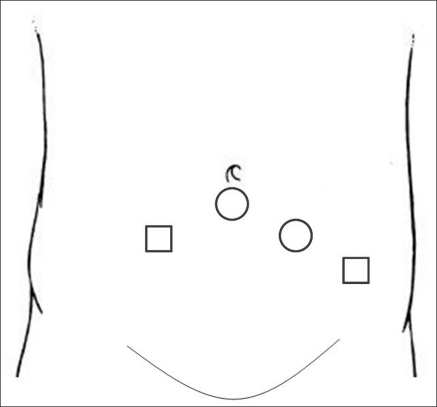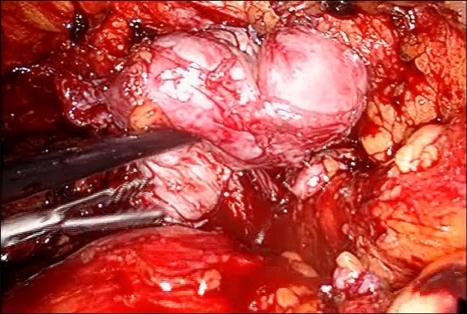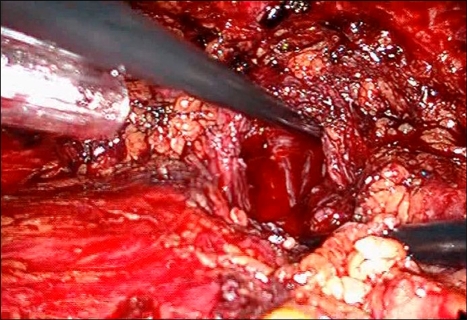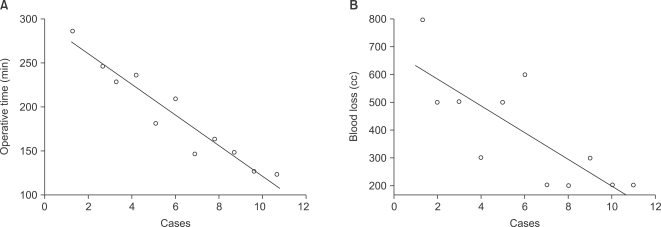Korean J Urol.
2010 May;51(5):323-329.
Early Experience with Laparoscopic Retropubic Simple Prostatectomy in Patients with Voluminous Benign Prostatic Hyperplasia (BPH)
- Affiliations
-
- 1Department of Urology, Daegu Fatima Hospital, Daegu, Korea. mdkjs99@hanmail.net
Abstract
- PURPOSE
Laparoscopic simple prostatectomy was recently developed to treat voluminous benign prostatic hyperplasia (BPH). We describe the surgical technique and assess the feasibility of laparoscopic simple prostatectomy through our early experience. MATERIALS AND METHODS: The medical records of 11 patients who underwent laparoscopic simple prostatectomy between March 2008 and January 2010 were retrospectively analyzed. The subjects were limited to the patients who satisfied the following conditions: prostate volume was at least 75 g, acute urinary retention repeatedly occurred or maximal flow rate (Qmax) was at most 10 ml/s, and International Prostate Symptom Score (IPSS) was at least 12. The surgery was performed by the laparoscopic extraperitoneal approach with a transcapsular route. Feasibility was assessed by objective operative parameters (reconversion, operating time, and blood loss) and perioperative complications. Data on short-term follow-up were also available. RESULTS: The mean age of the patients was 70.6 years. Mean preoperative prostate-specific antigen and prostate volume were 6.1 ng/ml and 109.3 cc, respectively. Mean operation time was 191.9 minutes and estimated blood loss was 390.9 cc. The resected adenoma weighed on average 72.4 g. No conversion to open surgery was required. Mean preoperative IPSS and quality of life (QoL) scores were 26.86 and 4.86. Mean Qmax, measured before the surgery, was 4.5 ml/s and residual urine was 106 ml. Mean postoperative IPSS and QoL scores were 4.2 and 1.5. After the surgery, mean Qmax was 15.5 ml/s and residual urine was 24.1 ml. CONCLUSIONS: In the case of voluminous BPH, laparoscopic retropubic simple prostatectomy is expected to be a useful treatment on the condition that the learning curve can be overcome with clinical experience.
Keyword
MeSH Terms
Figure
Reference
-
1. Baek M, Paick SH, Lee BK, Kang MB, Lho YS, Jung SI, et al. The efficacy of bipolar transurethral resection of the prostate in patients with large prostates (>80 g) and analysis of the postoperative results based on the resection ratio. Korean J Urol. 2008; 49:1087–1093.
Article2. Baumert H, Ballaro A, Dugardin F, Kaisary AV. Laparoscopic versus open simple prostatectomy: a comparative study. J Urol. 2006; 175:1691–1694. PMID: 16600732.
Article3. Sotelo R, Spaliviero M, Garcia-Segui A, Hasan W, Novoa J, Desai MM, et al. Laparoscopic retropubic simple prostatectomy. J Urol. 2005; 173:757–760. PMID: 15711263.4. Han M, Partin AW. Wein AJ, Kavoussi LR, Novick AC, Partin AW, Peters CA, editors. Retropubic and suprapubic open prostatectomy. Campbell-Walsh urology. 2007. 9th ed. Philadelphia: Saunders;p. 2845–2853.
Article5. van Velthoven R, Peltier A, Laguna MP, Piechaud T. Laparoscopic extraperitoneal adenomectomy (Millin): pilot study on feasibility. Eur Urol. 2004; 45:103–109. PMID: 14667525.6. Tubaro A, Vicentini R, Renzetti R, Miano L. Invasive and minimally invasive treatment modalities for lower urinary tract symptoms: what are the relevant differences in randomised controlled trials? Eur Urol. 2000; 7(Suppl):38.7. Mebust WK, Holtgrewe HL, Cockett AT, Peters PC. Transurethral prostatectomy: immediate and postoperative complications. A cooperative study of 13 participating institutions evaluating 3,885 patients. 1989. J Urol. 2002; 167:999–1002. PMID: 11908420.
Article8. Madersbacher S, Alivizatos G, Nordling J, Sanz CR, Emberton M, de la Rosette JJ. EAU 2004 guidelines on assessment, therapy and follow-up of men with lower urinary tract symptoms suggestive of benign prostatic obstruction (BPH guidelines). Eur Urol. 2004; 46:547–554. PMID: 15474261.
Article9. Mariano MB, Tefilli MV, Graziottin TM, Morales CM, Goldraich IH. Laparoscopic prostatectomy for benign prostatic hyperplasia--a six-year experience. Eur Urol. 2006; 49:127–131. PMID: 16314034.
Article10. Alivizatos G, Skolarikos A, Chalikopoulos D, Papachristou C, Sopilidis O, Dellis A, et al. Transurethral photoselective vaporization versus transvesical open enucleation of prostatic adenomas >80 ml: 12-mo results of a randomized prospective study. Eur Urol. 2008; 54:427–437. PMID: 18069117.11. Park JH, Son H, Paick JS. Comparative analysis of the efficacy and safety of photoselective vaporization of the prostate for treatment of benign prostatic hyperplasia according to prostate size. Korean J Urol. 2010; 51:115–121. PMID: 20414424.12. Hwang CH, Cho CK, Lee YK, Hong SJ. Comparative analysis of short-term efficacy and complication of photoselective vaporization for benign prostatic hyperplasia which was classified by prostate size. Korean J Urol. 2007; 48:826–831.
Article13. Kuntz RM, Lehrich K, Ahyai SA. Holmium laser enucleation of the prostate versus open prostatectomy for prostates greater than 100 grams: 5-year follow-up results of a randomised clinical trial. Eur Urol. 2008; 53:160–166. PMID: 17869409.
Article14. Moody JA, Lingeman JE. Holmium laser enucleation for prostate adenoma greater than 100 gm.: comparison to open prostatectomy. J Urol. 2001; 165:459–462. PMID: 11176396.
Article15. AUA Practive Guidelines Committee. AUA guideline on management of benign prostatic hyperplasia (2003). Chapter 1: diagnosis and treatment recommendations. J Urol. 2003; 170:530–547. PMID: 12853821.
Article16. Serretta V, Morgia G, Fondacaro L, Curto G, Lo bianco A, Pirritano D, et al. Open prostatectomy for benign prostatic enlargement in southern Europe in the late 1990s: a contemporary series of 1800 interventions. Urology. 2002; 60:623–627. PMID: 12385922.
Article17. Tubaro A, Montanari E. Management of symptomatic BPH in Italy: who is treated and how? Eur Urol. 1999; 36(Suppl 3):28–32. PMID: 10559628.
Article18. Lukacs B. Management of symptomatic BPH in France: who is treated and how? Eur Urol. 1999; 36(Suppl 3):14–20. PMID: 10559626.
Article19. Rey D, Ducarme G, Hoepffner JL, Staerman F. Laparoscopic adenectomy: a novel technique for managing benign prostatic hyperplasia. BJU Int. 2005; 95:676–678. PMID: 15705103.
Article20. Mariano MB, Graziottin TM, Tefilli MV. Laparoscopic prostatectomy with vascular control for benign prostatic hyperplasia. J Urol. 2002; 167:2528–2529. PMID: 11992078.
Article21. Nadler RB, Blunt LW Jr, User HM, Vallancien G. Preperitoneal laparoscopic simple prostatectomy. Urology. 2004; 63:778–779. PMID: 15072905.
Article22. Kim BH, Ryu DS, Oh TH. Initial experience of laparoscopic simple prostatectomy in patients with large benign prostatic hyperplasia. Korean J Urol. 2008; 49:418–423.
Article
- Full Text Links
- Actions
-
Cited
- CITED
-
- Close
- Share
- Similar articles
-
- Clinical Observation of Retropubic Prostatectomy in Treatment of Benign Prostatic Hyperplasia
- Experience with Retropubic Prostatectomy in Treatment of Benign Prostatic Hyperplasia
- Initial Experience of Three Cases of Radical Retropubic Prostatectomy
- Laparoscopic Simple Prostatectomy
- Clinical Observation on Benign Prostatic Hyperplasia






